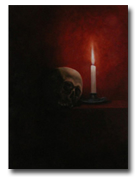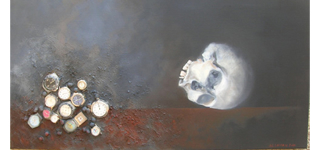Jean-Louis LAURAIN
Vanity
Pretentious paintings were a particuliar style of dead nature with a high symbolique value, which was developped in the XVII century, especially in Holland during the Baroque period.
 This title « vanity » and it's concept are followed in the latin vanitas vanitatum et omnia vanitas. It requires an invitation to meditate the futility of worldy pleasures in the face of death which awaits us. In vanity, the objects represented are all symbolic of things which are fragile or do not last for long: memento mori (remember that you are going to die). Of all these objects, the human skull is obviously a symbolic emblem. But, in addition, we frequently see a partially consumed candlestick, an hourglass or a watch, a bar of soap or fading flowers.
This title « vanity » and it's concept are followed in the latin vanitas vanitatum et omnia vanitas. It requires an invitation to meditate the futility of worldy pleasures in the face of death which awaits us. In vanity, the objects represented are all symbolic of things which are fragile or do not last for long: memento mori (remember that you are going to die). Of all these objects, the human skull is obviously a symbolic emblem. But, in addition, we frequently see a partially consumed candlestick, an hourglass or a watch, a bar of soap or fading flowers.
Vanity art almost completely disappeared in the XVIII century, before being resurrected by modern artists in the XX century. In a different context, which modifies it's treatment, the intention and perception, it is still present today in contempory art. But, to liberate theological references and essential morals of the definition of vanity in the XVII century, it leaves the place for freedom of interpretation by the artist and the spectator.
XVIII century, before being resurrected by modern artists in the XX century. In a different context, which modifies it's treatment, the intention and perception, it is still present today in contempory art. But, to liberate theological references and essential morals of the definition of vanity in the XVII century, it leaves the place for freedom of interpretation by the artist and the spectator.
Vanity has, since the very beginning, been a recurring theme in my work as a painter.